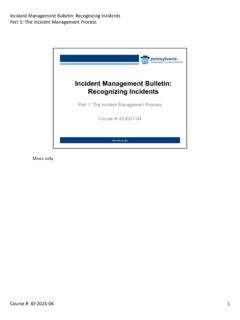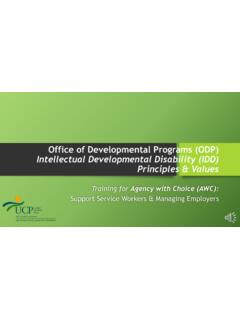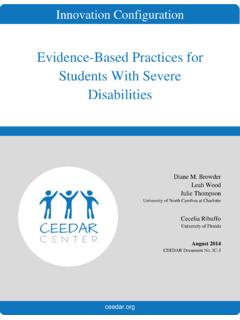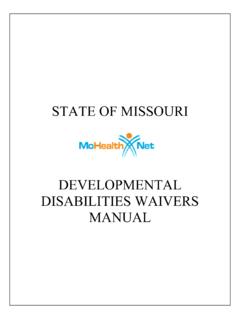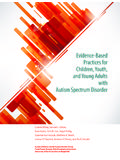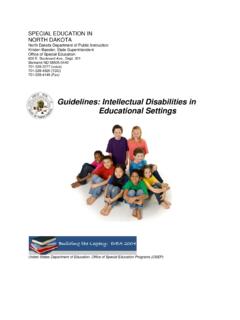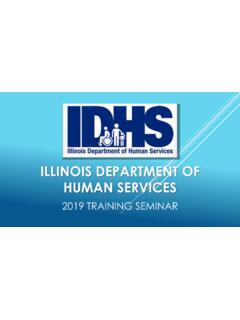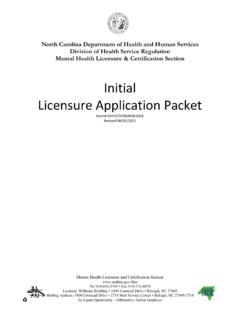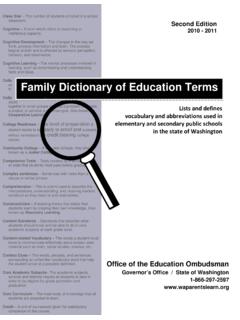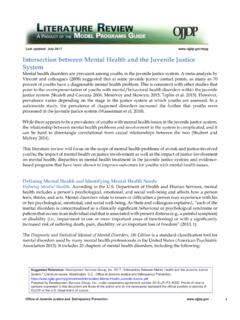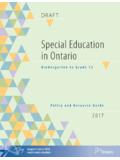Transcription of OFFICE OF DEVELOPMENTAL PROGRAMS BULLETIN
1 OFFICE OF. DEVELOPMENTAL . PROGRAMS BULLETIN . ISSUE DATE EFFECTIVE DATE NUMBER. February 5, 2021 February 5, 2021 00-21-01. SUBJECT BY. Guidance for Human Rights Teams and Human Rights Committees Kristin Ahrens, Deputy Secretary for DEVELOPMENTAL PROGRAMS SCOPE: Individuals Family Members Providers of Consolidated, Community Living, Person/Family Directed Support or Adult Autism Waiver services Agency with Choice Financial Management Services Providers Providers of Base-Funded services Adult Training Facilities licensed under 55 Pa. Code Chapter 2380. Vocational Facilities licensed under 55 Pa.
2 Code Chapter 2390. Community Homes for Individuals with an intellectual disability or Autism licensed under 55 Pa. Code Chapter 6400. Life Sharing Homes licensed under 55 Pa. Code Chapter 6500. Supports Coordination Organizations Providers of Targeted Support Management Administrative Entities (AEs). Other Interested Parties PURPOSE: The purpose of this BULLETIN is to provide guidance related to the formation and responsibilities of Human Rights Teams (HRTs) and Human Rights Committees (HRCs). and clarify the roles of all members of HRTs and HRCs in the management, approval, and oversight of restrictive procedures.
3 COMMENTS AND QUESTIONS REGARDING THIS BULLETIN SHOULD BE DIRECTED TO: The Appropriate DEVELOPMENTAL PROGRAMS Regional OFFICE Visit the OFFICE of DEVELOPMENTAL PROGRAMS Web site BACKGROUND: Protections of individual rights have been strengthened and oversight of these rights has been expanded as a result of 55 Pa. Code Chapter 6100, which addresses services for individuals with an intellectual disability or autism, revisions to licensing requirements in 55 Pa. Code Chapters 2380, 2390, 6400 and 6500, and the issuance of the federal Home and Community-Based Services Rule at 79 FR 2947. This BULLETIN clarifies requirements and provides best practice recommendations for the use of HRTs and HRCs to protect individual rights and for the review of restrictive procedures.
4 The guidance outlined in this BULLETIN aligns with the OFFICE of DEVELOPMENTAL Program's (ODP) mission, vision and values and reflects regulatory and contractual expectations for Administrative Entities (AEs) and providers. The requirements and recommendations discussed in this BULLETIN are intended to support a consistent approach to ensure an individual's health, safety, welfare and rights. DISCUSSION: All entities that are responsible for providing the services specified in Attachment 1, regardless of the setting where services are provided, are required to have access to an HRT. This can be through an internal HRT, an agreement with another provider, or (with AE approval) through an HRC.
5 In addition to providers being required to have HRTs, AEs and ODP's Bureau of Supports for Autism and Special Populations (BSASP) maintain a key role in overseeing the utilization of restrictive procedures within the service delivery system by operating HRCs. The operation of an HRC (either by an AE or by the BSASP) provides a consistent process for monitoring the use of restrictive procedures and a mechanism for systemic review of incidents involving restraints and rights violations. Through this systemic review, AEs and BSASP will be able to recognize and analyze trends in the data and facilitate activities to reduce the use of unnecessary restrictive procedures, improve practices associated with the use of restrictive procedures, and provide recommendations for improving the service delivery system.
6 All the information in this BULLETIN that addresses use of an HRT applies to providers that render services through all of the waivers, including the Adult Autism Waiver (AAW). However, the functions of the HRC discussed in this BULLETIN for participants enrolled in the AAW are fulfilled by BSASP instead of by an AE. This BULLETIN is also not intended to redefine what is considered to be a restrictive procedure. See 55 Pa. Code , , , and 2. I. Definitions Human Rights Team (HRT): A group tasked with reviewing utilization of restrictive procedures and determining if suggested strategies for intervention reflect the least restrictive intervention to support an individual's needs and maintain the individual's health, safety and well- being.
7 Human Rights Committee (HRC): A committee operated by an AE or by BSASP that is responsible for safeguarding the rights of individuals receiving services. The committee conducts systemic reviews of physical restraints and other restrictive procedures, develops systems to reduce or eliminate the need for physical restraints and restrictive procedures, provides technical assistance to providers to assist them in developing positive intervention strategies, and analyzes systemic concerns that impact the rights of individuals. Modification of Rights: A modification of rights is an allowable type of restrictive procedure that limits or prevents an individual from freely exercising his or her rights.
8 An individual's rights may only be modified to the extent necessary to mitigate a significant health and safety risk to the individual or others. Physical Restraint: A physical, hands on method of restrictive procedure that restricts, immobilizes, or reduces an individual's ability to move his or her arms, legs, head or other body parts freely. Physical restraints may only be used in the case of an emergency to prevent an individual from immediate physical harm to self or others, and may not be used for more than 30 cumulative minutes within a 2-hour period. Restrictive Procedure: A restrictive procedure is a practice that limits an individual's movement, activity or function; interferes with an individual's ability to acquire positive reinforcement; results in loss of objects or activities that an individual values; or requires an individual to engage in behavior the individual would not engage in given freedom of choice.
9 II. Human Rights Team (HRT): A. Purpose 3. HRTs should ensure that the provider is respecting, protecting, and promoting the human, civil, and legal rights of individuals the provider serves. Thus, the purpose of an HRT is to support individuals by providing a comprehensive multi-disciplinary team review of any modification of an individual's rights, including a proposed modification or the use of a restrictive procedure. The primary responsibility of an HRT is to protect the rights of individuals receiving services. Members of the HRT are responsible for ensuring that the use of restrictive procedures complies with the philosophy of least restrictive intervention.
10 This philosophy emphasizes that the modification of an individual's rights through the use of restrictive procedures is considered a drastic measure and should only be used as a last resort after all other interventions have been exhausted. The fundamental questions that should always be asked before implementing any allowable restrictive procedure are, Is there anything else that can be done that is less extreme or less intrusive that could keep the individual healthy and safe? . And, Can challenging behavior be addressed without having to resort to modifying the individual's rights by implementing a restrictive procedure?






